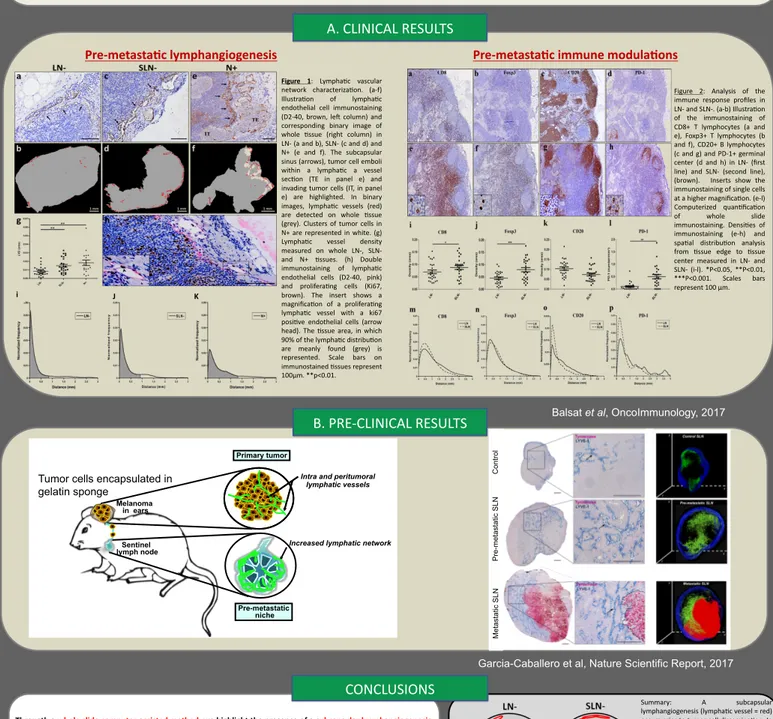Characterization of the pre-metastatic niche in
lymph node, in experimental and clinical settings
A. Noel
1
, C. Balsat
1
, M. Garcia-Caballero
1
, M. Vandevelde
1
, S. Blacher
1
and F Kridelka
2
BACKGROUND AND OBJECTIVES
1Laboratory of Tumor and Development Biology (GIGA-‐Cancer), University of Liège, Pathology Tower (B23), B-‐4000 Liège, Belgium. 2Department of Pathology, Laboratory of Experimental Pathology, GIGA-‐Cancer, University of Liege, Liege, Belgium. 3Department of Obstetrics and Gynecology, Hospital of la Citadelle, Liège, Belgium. 4Department of Obstetrics and Gynecology, CHU of Liège, B-‐4000 Liège, Belgium.
Clinical issue:
Lymph node status (N+/N-‐)
is a strong
prognos;c factor
of paQent’s cancer specific survival which is widely used to guide therapeuQc decisions. A pelvic
and/or para-‐aorQc lymph node dissecQon remains mandatory in order to confirm the histological nodal status. However, this
surgical staging
is associated
to therapeuQc
morbidity
(lymphodema). The laXer risk is parQcularly marked when an adjuvant radiaQon therapy is administrated a[er the surgery to
paQents diagnosed N+.
Current view: A specific dialogue between the primary tumor and the lymph node leads to the formaQon of a supporQve microenvironment for metastasis, the
pre-‐
metasta;c niche
. A beXer understanding of pre-‐metastaQc modulaQons that occur in the
sen;nel lymph node
(SLN), the first tumor draining lymph node
that remains the iniQal site of tumor metastasis is needed. A digital image analysis methodology assisted by computer was used to determine objecQvely
whole slide densiQes and spaQal distribuQons of immunostained structures (D2/40+ lymphaQc vessels, CD8, Foxp3, CD20 and PD-‐1).
Objec;ves: We aim at gecng
new insights
into the
lympha;c vessel dynamics and immune microenvironment
in the senQnel lymph node (SLN) on human early
cervical cancers (FIGO stage 1B1, n=50). We also set up an in vivo model reproducing the pre-‐metastaQc lymphangiogenic niche in lymph node.
Througth a whole slide computer-‐assisted method, we highlight the presence of a subcapsular lymphangiogenesis
that may facilitate the transport of tumor cells from the primary tumor to the SLN-‐. In addi;on to the presence of a T regulatory and cytotoxic lymphocyte rich microenvironment in the paracortex of SLN-‐ our data indicate a
modula;on of humoral immunity (B lymphocytes) in the superficial cortex, which is associated to a subcapsular lymphangiogenesis. All together, our data bring out that, in addi;on to provide a physical route for tumor cell dissemina;on, lympha;c vascular network could play a role in the modula;on of the humoral pro/an;-‐tumoral immune response in the SLN prior metastasis.
Pre-‐metasta;c lymphangiogenesis
A. CLINICAL RESULTS
i J J K
Figure 1: LymphaQc vascular
network characterizaQon. (a-‐f) IllustraQon of lymphaQc endothelial cell immunostaining (D2-‐40, brown, le[ column) and corresponding binary image of whole Qssue (right column) in LN-‐ (a and b), SLN-‐ (c and d) and N+ (e and f). The subcapsular sinus (arrows), tumor cell emboli within a lymphaQc a vessel secQon (TE in panel e) and invading tumor cells (IT, in panel e) are highlighted. In binary images, lymphaQc vessels (red) are detected on whole Qssue (grey). Clusters of tumor cells in N+ are represented in white. (g) LymphaQc vessel density measured on whole LN-‐, SLN-‐ and N+ Qssues. (h) Double immunostaining of lymphaQc endothelial cells (D2-‐40, pink) and proliferaQng cells (Ki67, brown). The insert shows a magnificaQon of a proliferaQng lymphaQc vessel with a ki67 posiQve endothelial cells (arrow head). The Qssue area, in which 90% of the lymphaQc distribuQon are meanly found (grey) is represented. Scale bars on immunostained Qssues represent 100µm. **p<0.01.
Pre-‐metasta;c immune modula;ons
Figure 2: Analysis of the immune response profiles in LN-‐ and SLN-‐. (a-‐b) IllustraQon of the immunostaining of CD8+ T lymphocytes (a and e), Foxp3+ T lymphocytes (b and f), CD20+ B lymphocytes (c and g) and PD-‐1+ germinal center (d and h) in LN-‐ (first line) and SLN-‐ (second line), (brown). Inserts show the immunostaining of single cells at a higher magnificaQon. (e-‐l) Computerized quanQficaQon of whole slide immunostaining. DensiQes of immunostaining (e-‐h) and spaQal distribuQon analysis from Qssue edge to Qssue center measured in LN-‐ and SLN-‐ (i-‐l). *P<0.05, **P<0.01, ***P<0.001. Scales bars represent 100 µm.
ParacorQcal hyperplasia (cytotoxic and regulatory T lymphocyte accumulaQon)
Summary: A subcapsular lymphangiogenesis (lymphaQc vessel = red) occurs prior to tumor cell disseminaQon. In addiQon to cytotoxic and regulatory T lymphocyte accumulaQon in the paracortex, this lymphangiogenesis is associated to humoral modulaQons: A PD-‐1+ germinal follicle (blue) accumulaQon in the superficial area, structure mainly composed by B lymphocytes, is linked to the presence of a subcapsular lymphangiogenesis.
B. PRE-‐CLINICAL RESULTS
CONCLUSIONS
Balsat et al, OncoImmunology, 2017
Garcia-Caballero et al, Nature Scientific Report, 2017
Tumor cells encapsulated in
gelatin sponge
Melanoma in ears Sentinel lymph node Pre-metastatic nicheIncreased lymphatic network Intra and peritumoral
lymphatic vessels Primary tumor C on tro l Pre -me ta st at ic SL N Me ta st at ic SL N
